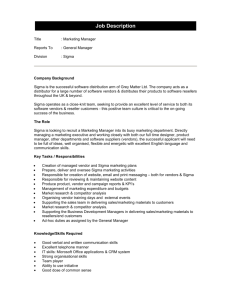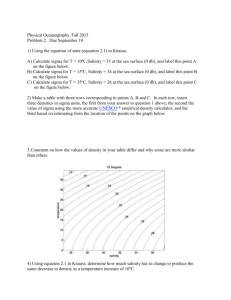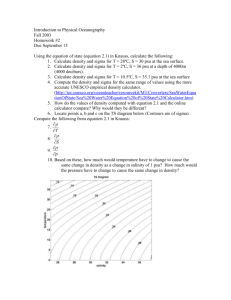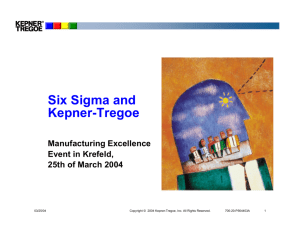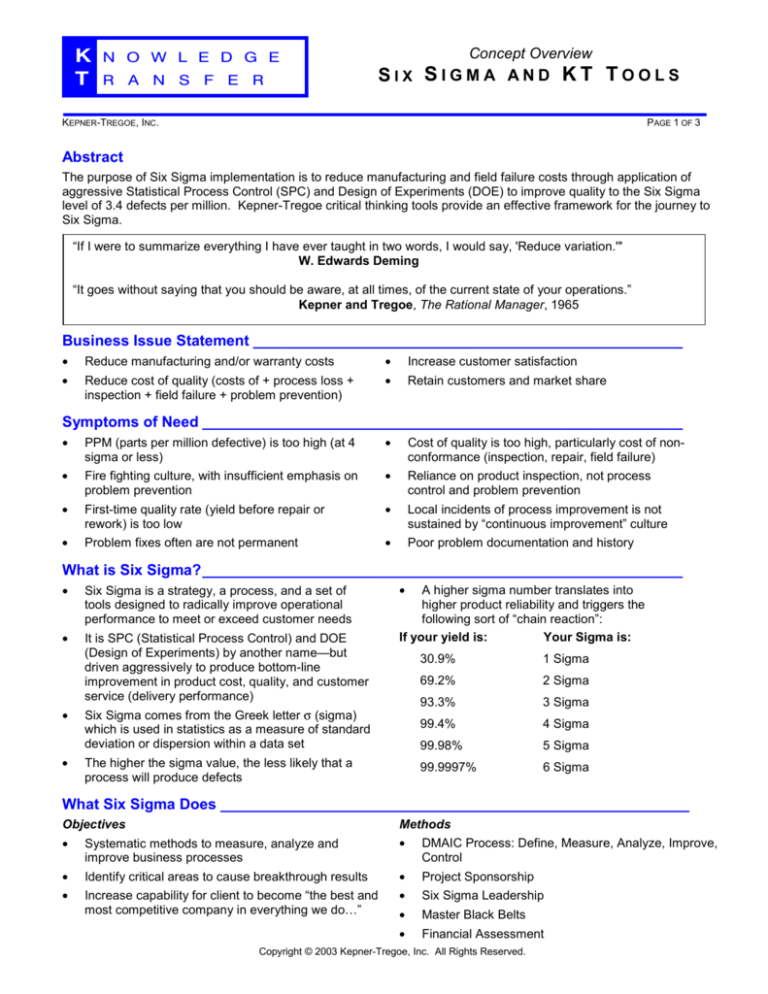
K
K
T
N O W L E D G E
R
A
N S
F E
R
Concept Overview
SIX SIGMA AND KT TOOLS
KEPNER-TREGOE, INC.
PAGE 1 OF 3
Abstract
The purpose of Six Sigma implementation is to reduce manufacturing and field failure costs through application of
aggressive Statistical Process Control (SPC) and Design of Experiments (DOE) to improve quality to the Six Sigma
level of 3.4 defects per million. Kepner-Tregoe critical thinking tools provide an effective framework for the journey to
Six Sigma.
“If I were to summarize everything I have ever taught in two words, I would say, 'Reduce variation.'"
W. Edwards Deming
“It goes without saying that you should be aware, at all times, of the current state of your operations.”
Kepner and Tregoe, The Rational Manager, 1965
Business Issue Statement ___________________________________________________
•
Reduce manufacturing and/or warranty costs
•
Increase customer satisfaction
•
Reduce cost of quality (costs of + process loss +
inspection + field failure + problem prevention)
•
Retain customers and market share
Symptoms of Need _________________________________________________________
•
PPM (parts per million defective) is too high (at 4
sigma or less)
•
Cost of quality is too high, particularly cost of nonconformance (inspection, repair, field failure)
•
Fire fighting culture, with insufficient emphasis on
problem prevention
•
Reliance on product inspection, not process
control and problem prevention
•
First-time quality rate (yield before repair or
rework) is too low
•
Local incidents of process improvement is not
sustained by “continuous improvement” culture
•
Problem fixes often are not permanent
•
Poor problem documentation and history
What is Six Sigma?_________________________________________________________
•
Six Sigma is a strategy, a process, and a set of
tools designed to radically improve operational
performance to meet or exceed customer needs
•
It is SPC (Statistical Process Control) and DOE
(Design of Experiments) by another name—but
driven aggressively to produce bottom-line
improvement in product cost, quality, and customer
service (delivery performance)
•
Six Sigma comes from the Greek letter σ (sigma)
which is used in statistics as a measure of standard
deviation or dispersion within a data set
•
The higher the sigma value, the less likely that a
process will produce defects
•
A higher sigma number translates into
higher product reliability and triggers the
following sort of “chain reaction”:
If your yield is:
Your Sigma is:
30.9%
1 Sigma
69.2%
2 Sigma
93.3%
3 Sigma
99.4%
4 Sigma
99.98%
5 Sigma
99.9997%
6 Sigma
What Six Sigma Does ________________________________________________________
Objectives
Methods
•
Systematic methods to measure, analyze and
improve business processes
•
DMAIC Process: Define, Measure, Analyze, Improve,
Control
•
Identify critical areas to cause breakthrough results
•
Project Sponsorship
•
Increase capability for client to become “the best and
most competitive company in everything we do…”
•
Six Sigma Leadership
•
Master Black Belts
•
Financial Assessment
Copyright © 2003 Kepner-Tregoe, Inc. All Rights Reserved.
Concept Overview
Page 2
SIX SIGMA AND KT TOOLS
What Kepner-Tregoe Does _____________________________________________________
Objectives
Methods
•
Effective action follows clear thinking
•
•
Apply the logic appropriate to each issue
Strategy Formulation, True Cost Analysis, High
Impact Improvements
•
Increase productivity by reducing time to get the best
solutions
•
•
Develop common logic/common language
•
Increase capability of people in client to “do for
themselves”
•
Problem Solving and Decision Making
Prioritize Issues/Plan Involvement
Root Cause Analysis
Select best option
Avoid problems
Project Management
•
Performance System Analysis
The Six Sigma Breakthrough Strategy _________________________________________
The DMAIC Approach
Once these five phases have been completed for all key processes in a business, major improvements in financial
results and customer satisfaction begin to accrue.
1. Define
Identify core processes and key customers
Prioritize activities
Identify resources
2. Measure
Select product quality characteristics
Define performance standards
Validate measurement systems
4. Improve
Screen potential causes
Discover variable relationships
Establish operating tolerances
5. Control
Validate measurement system
Determine process capability
Implement process controls
3. Analyze
Establish product capability
Define performance standards
Identify variation sources
Strategy Formulation
Potential Opportunity Analysis
DMAIC Methodology and KT Tools
Gatekeeper
Situation Appraisal
Performance System Design
Project Management
Project Selection
5
Control
1
Define
Potential Problem Analysis
Decision Analysis
Managing Involvement
2
Measure
4
Improve
True Cost Analysis
Statistical Process Control
3
Analyze
Performance System Analysis
Problem Analysis
Copyright © 2003 Kepner-Tregoe, Inc. All Rights Reserved.
www.kepner-tregoe.com
Concept Overview
Page 3
SIX SIGMA AND KT TOOLS
KT Processes for Phase 1: Define
Strategy Formulation: Use KT Strategy Formulation to identify critical products and customer groups for future
emphasis. This helps ensure that Six Sigma projects are targeted at strategically critical facets of the business.
Potential Opportunity Analysis: Use KT POA to focus on where the most significant benefits might be, and on how to
promote them and capitalize on them.
Situation Appraisal: Use Situation Appraisal to help quickly identify and prioritize problems or areas of concern to
charter potential Six Sigma projects.
Project Selection: Use KT Decision Analysis to identify which projects working on which processes have the greatest
benefit. This helps you to build an “Optimal Project Portfolio” that you can manage to fit your capacity and need.
KT Processes for Phase 2: Measure
True Cost Analysis: Use KT True Cost Analysis to measure the “hidden costs” of products and processes, and to
assess the financial impacts of performance deviations. Understanding True Cost puts the focus on those products
and processes that are central to the company’s strategy.
Statistical Process Control: These measures can fill in data about the “What, Where, When, and Extent” of the issue.
KT Processes for Phase 3: Analyze
Performance System Analysis: Use KT Performance System Analysis to understand the human causes of deviations.
Many times, the cause is not a broken part or a blown fuse, but a lack of clear direction and feedback or a “balance
of consequences” that tells workers, “No, don’t do it that way.”
Problem Analysis: Use KT Problem Analysis to increase process stability and capability by attacking causes. Use
Problem Analysis to identify the root cause of Special Cause variation, pinpointing differences and cause. In
Common Cause variation, use Problem Analysis to clarify the “Actual,” the “Should,” and the desired “Could.”
KT Processes for Phase 4: Improve
Managing Involvement: Use KT Managing Involvement to ensure appropriate participation in solution design.
Decision Analysis: Use KT Decision Analysis when choosing a course of action or solution to ensure the best choice
and to effectively manage risk.
Potential Problem Analysis: Use KT Potential Problem Analysis to manage possible threats to the project or plan (can
be used in place of or in conjunction with FMEA in many situations).
KT Processes for Phase 5: Control
Project Management: Use KT Project Management to manage the project, once the solution has been decided. The
full Project Management tool set and methodology is used in all phases of the project.
Managing Performance: Use KT Performance Management to address human performance issues. New processes
require new behavior and need a foundation of clear signals, visible consequences, and effective feedback. This can
help you avoid building a “technically correct” process atop a shaky balance of consequences.
KT Gatekeeper: Use KT Gatekeeper to monitor performance, and to control reintroduction of variation in both your
Product Portfolio and Project Portfolio.
Additional Information ______________________________________________________
For information on how Kepner-Tregoe can enhance your Six Sigma initiatives, and for related reading from KepnerTregoe, contact your account manager or info@kepner-tregoe.com. In the U.S.A., call 1-800-537-6378.
Related reading from Kepner-Tregoe:
Understanding Six Sigma—provides more detail on Six Sigma calculation, including key terms: Special and Common
Cause Variation, Process Stability and Capability, Standard Deviation and Six Sigma calculation.
The Seven Deadly Sins of Six Sigma—explores the common pitfalls of Six Sigma projects.
About Kepner-Tregoe
Since 1958, Kepner-Tregoe has helped clients achieve bottom-line strategic and operational results through training,
consulting, and facilitation. Our critical-thinking processes have played a foundational role in Six Sigma efforts at
many of the Fortune 500 companies.
Copyright © 2003 Kepner-Tregoe, Inc. All Rights Reserved.
www.kepner-tregoe.com




